
|
PIT00328 Мультиплексная CRISPR система Исследования CRISPR/Cas9 системы (см PIT00311 и ссылки там) пополнились мультиплексной системой, позволяющих редактировать сразу несколько генов. Исследования сосредоточены на тонкой настройки CRISPR/cas9 системы для новой платформы. Приводом яаляется многоступенчатая стратегия последовательного включения одноцепочечных sgRNA кассет в одну плазмиду. Литература приведена в конце поста. Чтобы понимать работу CRISPR системы, посмотрим на рисунки с подписями, которые заимствованы из поста Emily Carlson 17/12/2015 How the CRISPR System Works  The CRISPR system has two components joined together • a finely tuned targeting device (a small strand of RNA programmed to look for a specific DNA sequence) • and a strong cutting device (an enzyme called Cas9 that can cut through a double strand of DNA).  Once inserted into a cell, the CRISPR machine locates the target DNA sequence. CRISPR’s RNA recognizes and binds to the target DNA (circled in black).  The Cas9 enzyme cuts both strands of the DNA.  Researchers can introduce new genetic material, which the cell automatically incorporates into the gap when it repairs the broken DNA.  Among its many possible applications, the CRISPR system could be used to • Add a new gene that enables the organism to produce a pharmaceutical product (a biotechnology technique). • Help treat genetic diseases. • Create tailor-made model organisms to study human diseases. • Help produce replacements for damaged or diseased tissues and organs. References Cao, J., et al. “An easy and efficient inducible CRISPR/Cas9 platform with improved specificity for multiple gene targeting,” Nucleic Acids Research, 2016, DOI 10.1093/nar/gkw660. Dow, L., et al., “Inducible in vivo genome editing with CRISPR-Cas9,” Nature Biotechnology, 2015, doi 10.1038/nbt.3155. Kabadi, A., et al., “Multiplex CRISPR/Cas9-based genome engineering from a single lentiviral vector,” Nucleic Acids Research, 2014, DOI 10.1093/nar/gku749. Vidigal, J. and Ventura, A. “Rapid and efficient one-step generation of paired gRNA CRISPR-Cas9 libraries,” Nature Communications, 2015, DOI 10.1038/ncomms9083. Peter Belobrov 15 Sep 2016 12:30
© International Open Laboratory for Advanced Science and Technology — MOLPIT, 2009–2025
|